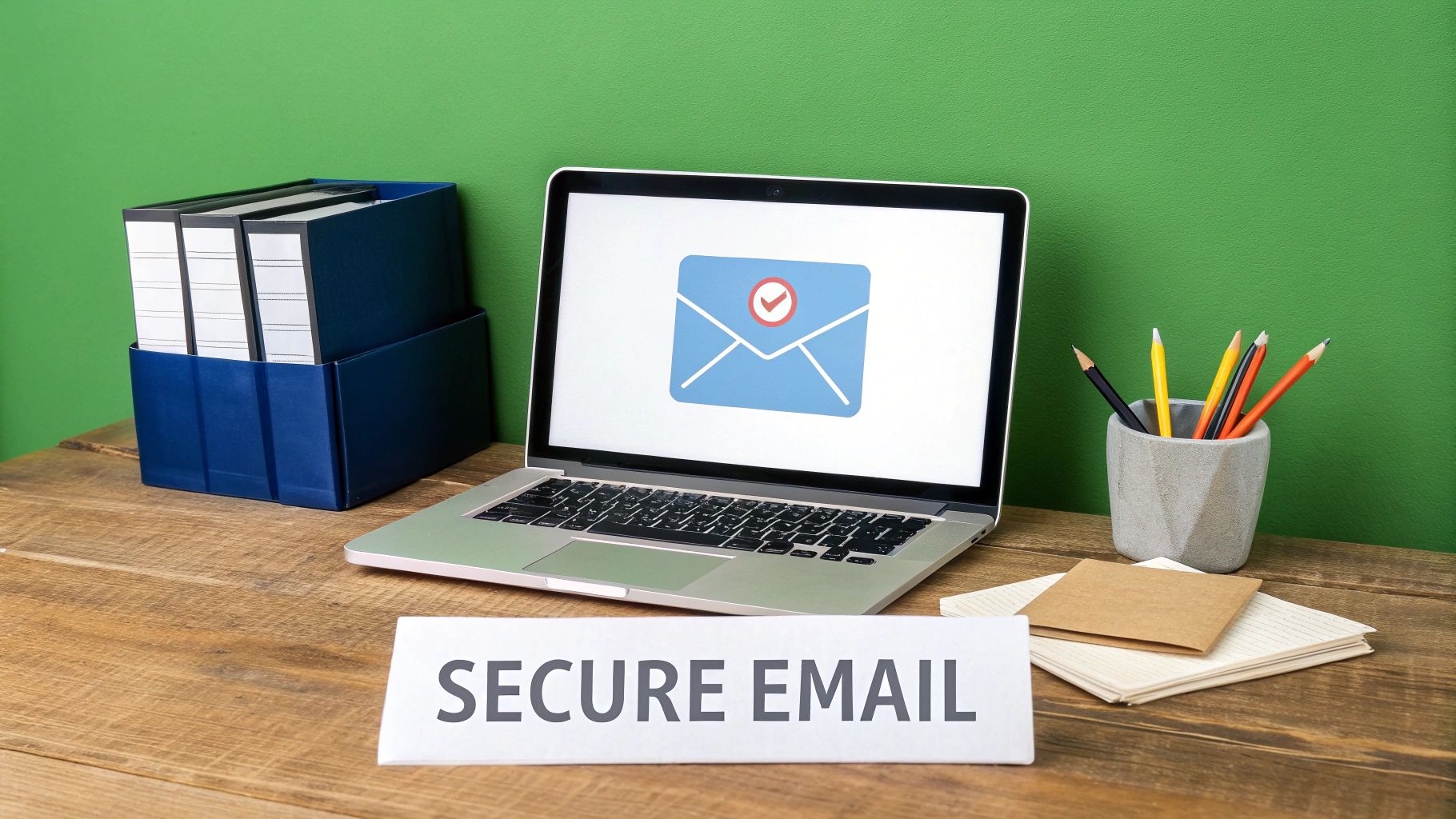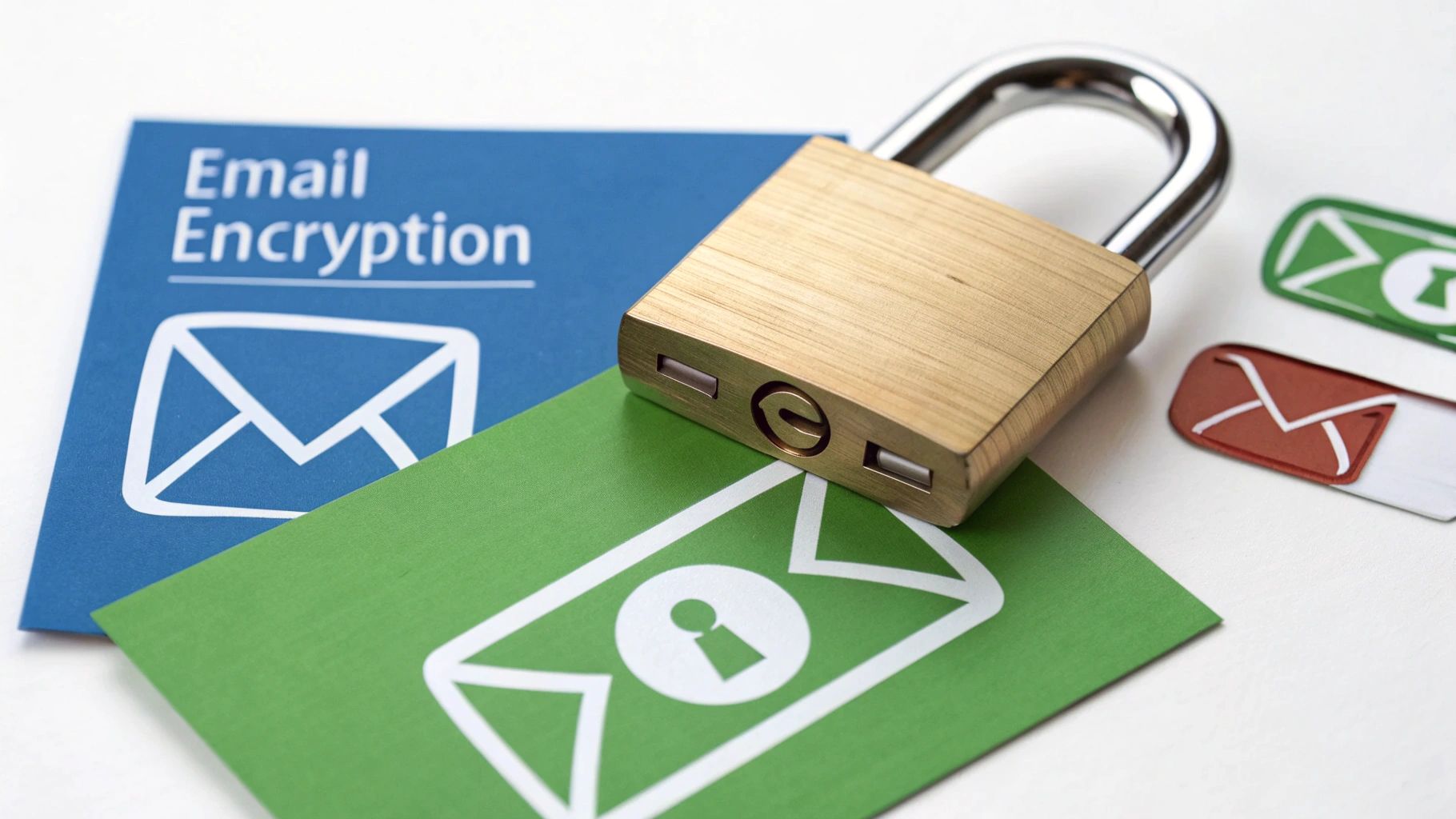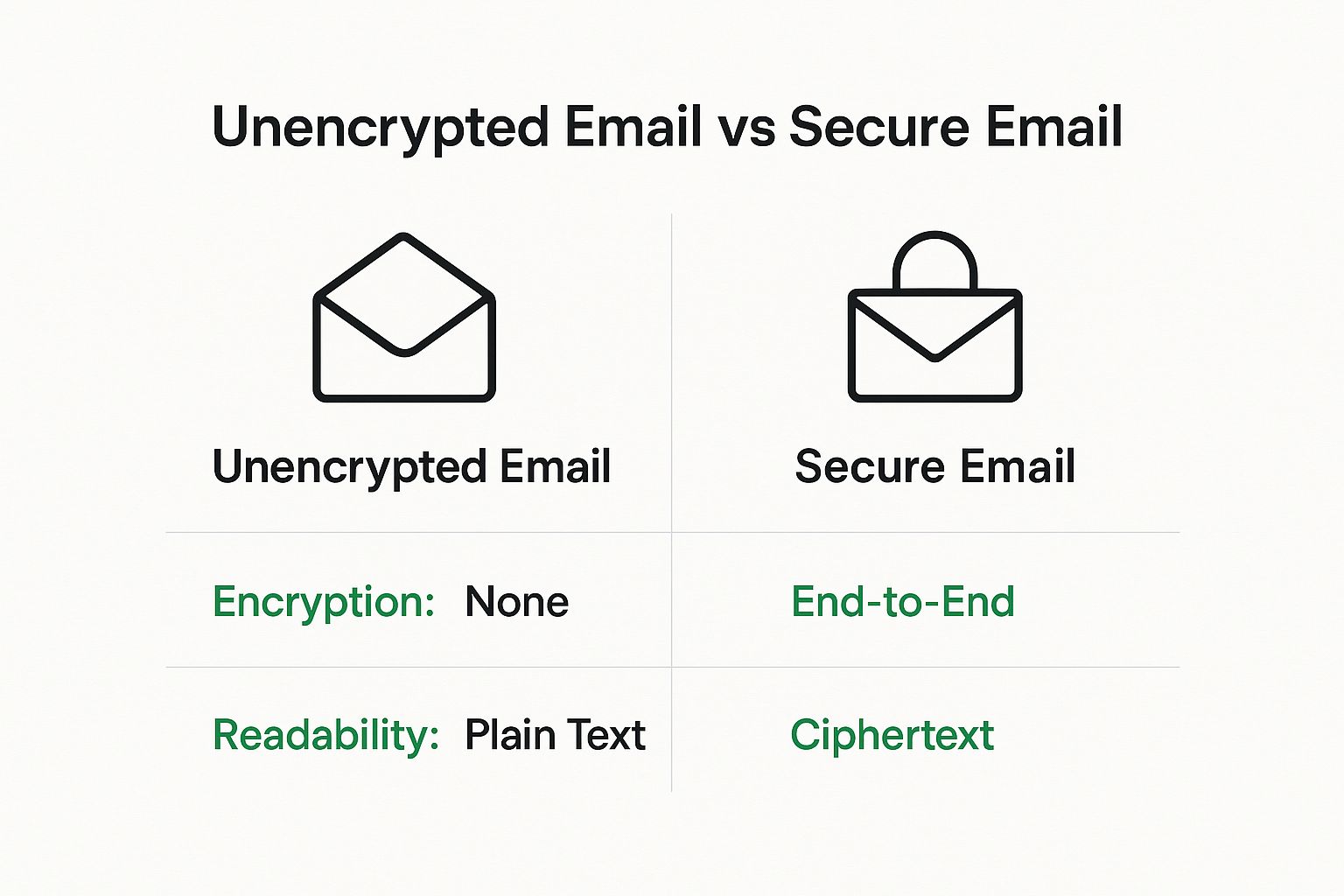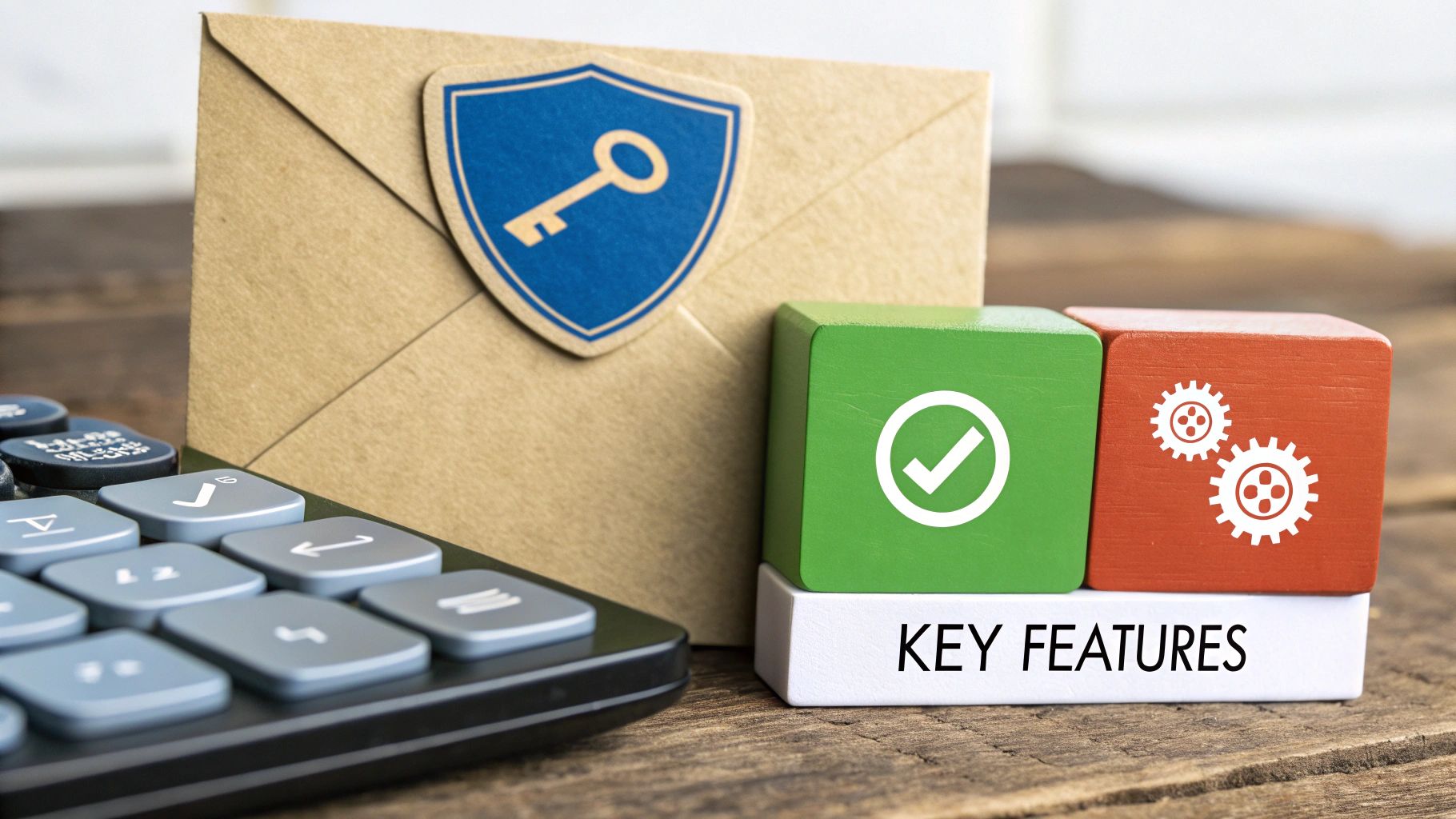What Is Secure Email? Essential Privacy Guide

The Real Story Behind Secure Email Protection

Email remains a cornerstone of communication for individuals and businesses alike. However, standard email platforms often lack the robust security needed to protect sensitive data from increasingly sophisticated cyber threats. This vulnerability has driven many, particularly in sectors like healthcare and law, to seek more secure alternatives. But what does secure email truly entail?
It's more than just a label. True secure email represents a fundamental shift in how messages are protected. Think of it as building a digital fortress around your communications, ensuring only authorized access. The difference is similar to sending a postcard versus a sealed letter. A postcard is open for anyone to read, while a sealed letter preserves confidentiality. Secure email aims to replicate that same level of privacy in the digital world.
Understanding The Need For Secure Email
The rise in data breaches and complex cyberattacks has made email security paramount. Traditional email systems often fall short in providing adequate safeguards against these threats, leaving sensitive information vulnerable. Understanding the realities of secure email protection is therefore critical. You might be interested in learning more about secure communication platforms like Typewire.
The global email security market is experiencing significant growth. Valued at USD 18.5 billion in 2024, it's projected to reach USD 24 billion by 2030, with a CAGR of 4.4%. This expansion is driven by the ever-evolving threat landscape, with organizations facing increasingly complex cyber threats targeting their email systems. More detailed statistics can be found here. This underscores the need for investment in robust email security solutions.
Key Components Of Secure Email
Several key components differentiate truly secure email from platforms simply claiming enhanced security. These elements work in concert to create a multi-layered defense against a range of cyber threats.
-
Encryption: This process scrambles the content of your message, rendering it unreadable to anyone except the recipient possessing the correct decryption key.
-
Authentication: This verifies the sender's identity, ensuring messages aren't forged or spoofed.
-
Metadata Protection: This safeguards information about your communication, such as sender, recipient, time, and location, preventing attackers from exploiting these valuable details.
These features are essential for protecting both personal and professional communications. They provide a strong defense against data breaches and other cyber threats, ensuring confidentiality and peace of mind in our digital age.
Encryption Demystified: How Secure Email Actually Works
Beyond marketing hype, how does secure email actually protect your messages? The process involves converting your readable message into an unreadable format, securely transmitting it, and then converting it back to a readable format for the recipient. This core process relies on encryption.
The Role of Encryption
Encryption functions like a digital lock and key for your emails. Imagine writing a letter, placing it in a locked box, and sharing the combination only with the intended recipient. This combination is your encryption key. Anyone intercepting the box can't unlock it without the combination. Encrypted emails work similarly, remaining unreadable to unauthorized individuals without the decryption key.
The demand for secure communication is significantly impacting the email encryption market. Valued at USD 6.4 billion in 2025, it's projected to reach USD 31.1 billion by 2034. This represents a remarkable 22.5% CAGR. This growth underscores the rising importance of data protection across various industries. You can find more detailed statistics here. This growth is fueled by the increasing need for secure communication across all sectors, continuous advancements in encryption technologies, and the rise of robust security solutions.
Types of Encryption and How They Work
Different encryption methods offer varying degrees of security. End-to-end encryption (E2EE) is a powerful method where only the sender and recipient possess the decryption keys. It creates a secure channel directly between the two parties, preventing intermediaries from accessing message content. Other methods, such as TLS, secure the connection between email providers and servers, protecting the message in transit. For more information on security measures, explore Whisper.ai’s Security offerings.
Authentication and Metadata Protection: Additional Layers of Security
While encryption protects message content, authentication verifies the sender's identity. This helps prevent email spoofing and phishing attacks by verifying the sender's legitimacy. Furthermore, metadata protection safeguards information about your communication, such as sender/recipient details and timestamps. This prevents attackers from gathering intelligence based on your communication habits.
These combined elements establish a strong security framework, transforming secure email from a desirable feature into a critical component of protecting sensitive data.
Email Threats That Keep Security Experts Up at Night

The email threat landscape is constantly changing. It's moved beyond simple spam and into a world of complex attacks designed to get past even the strongest security. This makes having secure email more important than ever.
Phishing: The Art of Deception
Phishing attacks are a major worry. These deceptive emails try to trick you into giving up sensitive information like passwords, credit card numbers, or personal data. Phishing scams have become very advanced, often looking exactly like real messages from companies you trust. This makes it incredibly tough to spot the fakes.
Business Email Compromise (BEC): A Costly Threat
Business email compromise (BEC) is another serious problem. These attacks usually target companies. Criminals pretend to be executives or vendors to trick employees into authorizing fake payments or giving up confidential data. BEC attacks have cost businesses millions of dollars and can really hurt their reputations.
To better understand the dangers companies face through email, take a look at the table below. It outlines some of the most prevalent threats.
| Threat Type | Description | Common Techniques | Potential Impact |
|---|---|---|---|
| Phishing | Deceptive emails aimed at stealing sensitive information. | Spoofed emails, malicious links, fake login pages. | Identity theft, financial loss, data breaches. |
| Business Email Compromise (BEC) | Attacks targeting businesses to initiate fraudulent payments. | Impersonating executives or vendors, requesting urgent transfers. | Financial loss, reputational damage. |
| Malware | Malicious software delivered via email attachments. | Infected documents, executable files. | System compromise, data loss, ransomware attacks. |
| Spam | Unsolicited bulk emails. | Advertising unwanted products or services, distributing malware. | Wasted time, reduced productivity, potential security risks. |
This table shows just how important robust email security is. By understanding the various types of threats, businesses can be better equipped to protect themselves.
The Rise of AI-Powered Attacks
Criminals are now using artificial intelligence (AI) to make their attacks even better. AI can create very personalized phishing emails that are harder to detect. It can also automate attacks, making them faster and more widespread. This means old-fashioned security just isn’t good enough anymore.
In 2022, malicious phishing emails went up by a massive 569%, with credential phishing reports increasing by 478%. These numbers show that traditional email security methods are struggling to keep up. You can learn more about this from Fortune Business Insights.
Why Secure Email Is Essential
These growing threats show why secure email is absolutely essential. Secure email solutions use strong encryption and authentication to keep your messages safe and ensure they haven't been tampered with. This involves verifying who really sent the email and protecting the content itself. These steps provide crucial protection against today's complex email threats, keeping both your personal and work communications safe.
Must-Have Features in Truly Secure Email Solutions
Choosing the right secure email service requires understanding the key features that distinguish genuinely secure platforms from those offering only superficial protection. Not all services are created equal.
Essential Security Features
To ensure your messages remain confidential and protected, look for these vital features:
-
Robust Encryption: End-to-end encryption (E2EE) is crucial. This ensures only you and your intended recipient can read your messages. Avoid services that offer only transport layer security (TLS). TLS only protects the message in transit between servers, not the content itself.
-
Strong Authentication: Two-factor authentication (2FA) and other robust authentication measures verify the sender's identity, preventing impersonation and phishing attacks. This ensures you know exactly who you're communicating with.
-
Metadata Protection: Secure email providers should also protect the information about your emails, such as sender/recipient details and timestamps. This prevents attackers from gaining insights from your communication patterns.

The infographic above visually contrasts unencrypted email with secure email. Unencrypted email leaves your messages as plain text, vulnerable to interception. Secure email, using end-to-end encryption, transforms your message into ciphertext, unreadable without the proper decryption key.
To help you make an informed decision, we've compiled a comparison of leading secure email providers:
Battle-Tested Secure Email Providers Compared
This table evaluates leading secure email providers based on critical security features, real-world performance, and value factors.
| Provider | Encryption Type | Key Features | Free Plan Available | Paid Plans Starting At | Best For |
|---|---|---|---|---|---|
| ProtonMail | End-to-end encryption | Secure calendar, VPN, drive | Yes | $5/month | Privacy-conscious users |
| Tutanota | End-to-end encryption | Open source, encrypted calendar | Yes | $1.50/month | Budget-minded users |
| Mailfence | End-to-end encryption | Integrated documents, calendar, contacts | Yes | $3/month | Businesses and teams |
This table highlights the varying features and pricing of secure email providers. While all offer end-to-end encryption, their additional features and costs differ, catering to various needs.
Privacy-Focused Policies
A provider's commitment to your privacy extends beyond technical features. Examine their privacy policy. Look for transparency about data handling, clear statements on data logging, and minimal data collection. For a better understanding of industry standards, review data privacy best practices.
Usability and Accessibility
Secure email shouldn't be cumbersome. The best services balance strong security with user-friendly interfaces and seamless device integration. Features like mobile apps, intuitive key management, and easy contact importing make secure email practical for everyone.
Pricing and Support
Consider the pricing structure and available support. Look for transparent pricing plans that meet your needs. Reliable customer support is essential for troubleshooting and answering security questions. For details on Typewire's pricing, see their pricing page.
Choosing a secure email provider requires careful consideration. By understanding these features and policies, you can prioritize the security and privacy of your communications.
Setting Up Your Secure Email System Without Headaches

Transitioning to a secure email system may seem like a complex undertaking, but it can be surprisingly straightforward. This guide offers practical steps for a seamless move, regardless of your technical background. Think of it as an upgrade—some learning is involved, but the enhanced security and benefits are worth the effort.
Choosing The Right Provider
The first step is selecting an email provider that meets your specific needs. Much like choosing any important service, consider factors like security features, user-friendliness, and cost. Carefully evaluate providers based on their encryption methods, authentication protocols, and privacy policies.
-
Encryption: Prioritize providers using robust encryption, ideally end-to-end encryption. This ensures that only you and your intended recipient can decipher your messages.
-
Authentication: Look for strong authentication measures, such as two-factor authentication (2FA). This added layer of security significantly reduces the risk of unauthorized access. Learn more about 2FA
-
Privacy Policy: A clear and transparent privacy policy is essential. It should explicitly outline what data is collected, how it's used, and the measures taken to protect it.
Managing Your Encryption Keys
Encryption keys are the digital equivalent of a key to a secure vault. They are essential for decrypting your secure emails. Most providers simplify key management, making it accessible even for those less technically inclined. Some even offer automated key backups to protect against accidental loss.
Setting Up Your Devices
After choosing a provider, setting up your devices is typically a simple process. Most providers offer dedicated apps for various devices, including smartphones and computers. This allows you to access your secure email conveniently from anywhere, much like standard email platforms. The process is usually as easy as downloading the app and logging in.
Migrating Contacts And Managing The Transition
Moving your existing contacts to your new secure email provider is usually facilitated through import features. Many providers offer automated tools to streamline this task. During the transition, notify your important contacts about your new secure email address to ensure uninterrupted communication.
Establishing Good Security Habits
Secure email is just one component of a comprehensive security strategy. Like any security measure, good habits are crucial. This includes creating a strong, unique password, exercising caution with suspicious emails, and regularly updating your software. These practices maximize the effectiveness of your secure email system and protect your confidential communications.
By following these steps and selecting a provider like Typewire, which offers robust security features, custom domain hosting, and 24/7 support, you can smoothly transition to secure email and enjoy enhanced peace of mind. It's a valuable investment in the privacy and security of your communications. Learn more about Typewire's secure email hosting at their website.
Enterprise-Grade Security: Secure Email for Organizations
Balancing robust email security with operational efficiency is a complex challenge for organizations, especially those with a large workforce. This section explores how leading companies successfully implement secure email without compromising productivity.
Meeting Regulatory Requirements
Meeting regulatory requirements is a key challenge. Regulations like GDPR and HIPAA mandate strict data protection measures, especially for sensitive information sent via email. Secure email solutions, with their focus on encryption and access control, are vital for achieving and maintaining compliance. This proactive approach helps organizations avoid penalties and protect their reputation.
Integrating With Existing Infrastructure
Integrating secure email systems with existing IT infrastructure is another important consideration. Seamless integration minimizes workflow disruptions and encourages user adoption. Solutions like Typewire, for example, offer features that simplify integration and user management. This allows organizations to bolster security without sacrificing operational efficiency. You might be interested in: Typewire for Business.
Employee Training and Security Protocols
Effective employee training on security protocols is essential. Regular training educates employees about potential threats like phishing and reinforces best practices for secure email usage. This fosters a culture of security awareness, ultimately strengthening the effectiveness of any secure email implementation.
Justifying the Investment
Demonstrating a return on investment (ROI) for secure email can be crucial for organizational buy-in. The costs associated with data breaches, including financial penalties and reputational damage, often significantly outweigh the investment in a secure email platform. By quantifying these potential risks, IT leaders can effectively justify the expense and highlight the long-term value of robust email security.
Case Studies and Policy Frameworks
Examining case studies of successful secure email implementations provides valuable insights. These examples demonstrate best practices and illustrate the tangible benefits of prioritizing email security.
Developing comprehensive email security policies is also essential. These policies should outline procedures for handling sensitive data, managing access controls, and responding to security incidents. Clear guidelines empower employees to make informed decisions, further strengthening the organization's security posture.
What's Next: The Evolution of Secure Communication
The world of secure email is constantly evolving. New threats emerge, technology advances, and the way we communicate changes. This section explores the future of secure email and how emerging trends will impact your communications.
The Quantum Computing Question
Quantum computing presents both immense opportunities and significant challenges to current encryption standards. Its immense processing power could potentially break widely used encryption algorithms, leaving current secure email systems vulnerable.
This means the future of secure email hinges on the development of quantum-resistant cryptography. This active research area focuses on creating new encryption methods designed to withstand the power of quantum computers. The transition to these new standards will be crucial for maintaining secure email in the quantum age.
The Double-Edged Sword of AI
Artificial intelligence (AI) plays a dual role in the future of secure email. On one hand, AI is being used to create more sophisticated phishing attacks, blurring the lines between legitimate and malicious emails.
On the other hand, AI is also powering more advanced threat detection systems. These systems can analyze massive amounts of data to identify and block emerging threats more efficiently. The ongoing battle between AI-powered attacks and AI-powered defenses will significantly shape the future of email security.
For example, in 2025, Google announced the deployment of a new AI-powered threat detection model in Gmail that analyzes multiple signals to improve spam and phishing detection. This advancement demonstrates the growing role of AI in bolstering email security.
Emerging Technologies and Decentralization
Several emerging technologies are poised to impact secure communication. Decentralized systems, for example, challenge the traditional centralized email model.
These systems aim to improve privacy and security by distributing control and data across a network, making it harder for attackers to exploit a single vulnerability. This could lead to innovative approaches in securing and managing email communications.
The Future of User Experience
User experience is another key development area. Making secure email user-friendly is vital for widespread adoption. Innovations like simplified key management and easier setup processes will make it simpler for individuals and organizations to adopt and maintain secure email systems.
Regulatory Changes and Email Privacy
The regulatory landscape around data privacy is constantly shifting. New regulations, similar to GDPR, are likely to emerge, influencing how email providers manage user data.
These regulations may emphasize data minimization, transparency, and user consent, potentially driving the adoption of privacy-enhancing technologies and practices within the secure email ecosystem.
These developments highlight the need to stay informed about the evolving secure email landscape. By understanding these trends, you can make informed decisions about your communication security and choose solutions like Typewire that are positioned to adapt to the future of secure email. Secure your email today with Typewire.
What Is Secure Email? Essential Privacy Guide
Posted: 2025-05-15
Choosing an Encrypted Email Solution for Your Business
Posted: 2025-12-14
What is email deliverability: Your guide to inbox success
Posted: 2025-12-13
What Is SMTP Authentication? A Guide to Email Security and Privacy
Posted: 2025-12-12
How to Create Email Templates Securely and Effectively
Posted: 2025-12-11
Unlock Inbox Peace: How Can I Stop Receiving Spam Emails and Reclaim Control
Posted: 2025-12-10
Discover how to send encrypted emails: A practical guide to secure messaging
Posted: 2025-12-09
How to Host an Email Server: A Guide to Privacy and Security
Posted: 2025-12-08
10 Secure Email Communication Best Practices for 2025
Posted: 2025-12-07